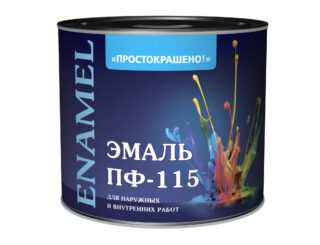Scratches appear on the laminate, the top layer is erased when rearranging furniture, walking in shoes. When eliminating the defect, the shade of the mastic may not match, areas of the putty will be visible, so the color of the floor is updated over the entire area. Laminate paint is selected for its technical characteristics and properties so that it has good adhesion to the surface.
The need to stain the laminate
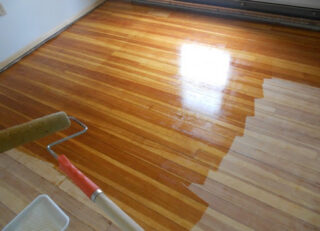
Laminate is classified as a durable flooring, but it also deteriorates over time. To extend the life, you can paint the laminate in a different color. Actions are referred to as compulsory measures, because the painted layer must be carefully looked after afterwards and the paint layer must be restored every year or two.
The need to change the color arises if the laminate was repaired, for example, puttying of individual places, replacement of boards. These areas are highlighted on the surface and require the entire laminate to be painted. The work can be done independently at home, without the involvement of experienced workers.
They pre-calculate the cost of the materials that need to be purchased, take into account the free time for restoration. The work itself takes a long time, includes a preparatory process, the application of several layers of paint, primer, putty, varnishing.
Selection of paints and varnishes
The correct selection of the composition for the application affects the result of painting the laminated coating. The lamellas are covered with an airtight durable film at the time of release. It is a smooth layer on the surface that is difficult to adhere to paint formulations. If the roughness is not artificially increased, the paint will quickly lag behind the laminate surface.
Partial matting of the laminate will increase the ability to absorb moisture, therefore a varnish with a protective effect is applied over the paint. The paint is chosen to obtain a durable layer on the surface that has good adhesion to the laminate and will not roll off during use or immediately after drying.
The plasticity of the resulting film is important, since laminate is referred to as a free covering that flexes and moves under load.
Alkyd paints
Depending on the varnish used, alkyd paints are divided into types:
- glyphthalic;
- pentaphthalic.
The first dries for a long time, a hard film forms in a day at a temperature above + 20 ° C. The setting time is reduced with uniform heating to 60 - 85 ° C or the introduction of hardeners. After curing (about two weeks), the coating is difficult to scratch and dissolve. The surface does not require polishing. You can dilute the paint with a solvent, but not more than 30%.
Pentaphthalic compounds are common for interior decoration, they are produced on the basis of alkyd varnishes. The category includes the previously popular PF-115 and PF-226. For coloring the laminate, it is better to use the first grade, because it is highly durable. Alkyd paints are applied to the primed surface, diluted with solvent solvent, drying oil, white spirit.
Polyurethane compounds
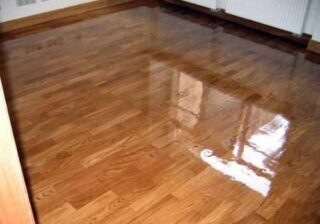
Produced on the basis of polycondensation resins, as a result, a high-quality coating agent for laminate with high technical characteristics is obtained. Two-component mixtures are used, which are combined before application, and ready-to-use paints.
Properties of the resulting layer:
- large margin of safety and abrasion resistance;
- good adhesion to the prepared surface of the laminated board;
- safety for human health;
- elasticity and ability to bend slightly;
- resistance to aggressive air components and fats.
The mixture during the manufacture is modified with copolymers based on polyurethane, while the substances are dissolved with toluene, xylene, pigments are introduced for color. The film on the surface of the layer appears under the influence of moisture from the atmosphere, therefore it is not recommended to use a hair dryer for drying. The coating is ready for use in two days, when it gains 100% water resistance and strength.
Features of painting
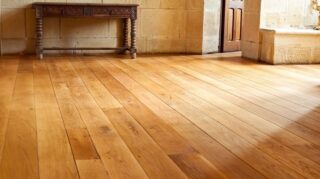
It is better to repaint the laminate with compounds that contain less liquid. Otherwise, moisture will be absorbed into the prepared rough surface, the boards will swell and deform. They use alkyd or polyurethane-based products. Do not use water-based and acrylic paints.
The compositions provide a resistant layer that protects the lamellas from further destruction. If the surface of the boards is not mechanically damaged, they are limited only to varnishing. The varnish is also applied to the painted layer, while the type of material is chosen according to the type of paint.
Before repainting the laminate, you need to do surface preparation. The laminated layer is thin, you need to sand the area so as not to damage the main layer inside the board. Otherwise, then it will be necessary to additionally level the depressions with putty. If there are already chips and cracks, they must be sealed with paste.
Preparatory work
The complexity of preparation depends on the deterioration of the laminate. Sometimes only sanding is enough, in other cases a serious repair is needed before painting.
Stages of preparation:
- cleaning the floor from dirt with a damp cloth;
- putty of potholes, cracks, gaps between the boards;
- waiting for the areas to dry, cleaning off excess material;
- giving a matte finish to the laminated coating with emery;
- cleaning garbage with a vacuum cleaner;
- wiping the surface with a soft, lint-free cloth dampened with solvent.
Each lamella is sanded separately, while the degree of pressure is adjusted so that after matting, an even area remains. White spirit or an acetone-based product is used as a solvent.
Required tools and materials
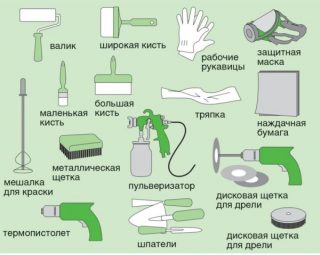
You will need a vacuum cleaner, which is used after each use of sandpaper. Dust is absolutely unacceptable during priming or painting.
Tools for the job:
- masking tape;
- sandpaper (No. 60 for matting the laminate, No. 120 - 140 for cleaning the putty);
- clean soft rags;
- rubber spatula for applying putty;
- brush for repainting hard-to-reach areas, roller;
- a tray for paint with a spinning shelf;
- respirator, gloves.
The paint is pentaphthalic or based on polyurethane. The solvent is used for alkyd compositions. Diluted paint is used as a primer, or drying oil is used (it dries for a long time). Close up of cracks with acrylic putty on wood. The varnish is used with epoxy color or polyurethane transparent.
Diy laminate staining technology
Paint from the wall removed from the entrance. The paint is collected on a roller or brush, rolled in each separate area along and across. They try to make smooth transitions between plots. Areas near the skirting boards and the joints between the panels are painted with a brush.
The first layer is left to dry for the time indicated on the paint package. It is recommended to close doors and windows so that there are no drafts and drying takes place in a natural environment.Insects can fly into the room and stick to the surface.
The second layer is applied according to the technology of the first, left to dry for the same time. The paint is varnished to prolong its working time. A wide brush or roller is used, the surface is varnished 3-4 times, each time waiting for the last layer to dry completely.

